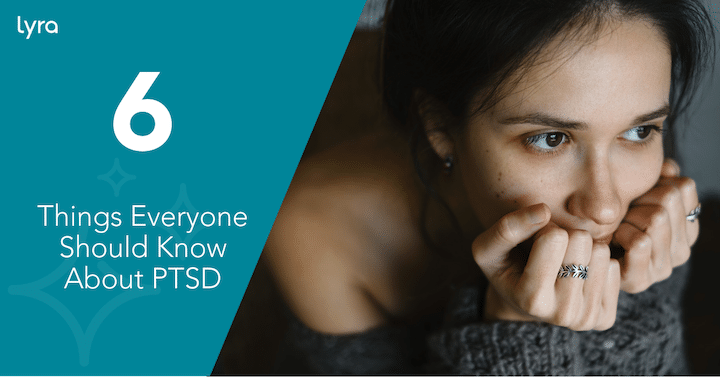Thanks for subscribing!
You will now receive future content from Lyra Health.

Most of us are exposed to trauma at some point in our lives. This may mean surviving or witnessing a life-threatening event such as a car accident or fire, or ongoing traumatic circumstances like domestic violence. After going through trauma, it’s normal to have a range of reactions such as stress, sleep problems, or difficulty concentrating. But for some, the symptoms persist, leading to a diagnosis of post-traumatic stress disorder, or PTSD.
For many people, the term “PTSD” evokes images of extreme danger such as military combat or a mass shooting. While survivors of events like these sometimes experience post-traumatic stress disorder, in reality, PTSD could potentially affect anyone who has been exposed to significant trauma.
In honor of PTSD Awareness Month, we’re breaking down six key things you should know about the disorder to help you separate fact from fiction.
PTSD affects more people than you might think, and can develop at any age. Roughly 8 million U.S. adults experience PTSD in a given year, and seven to eight percent of the population will have PTSD at some point in their lives, according to the U.S. Department of Veterans Affairs. The VA also reports that women are more than twice as likely to experience PTSD as men, with about 10 percent of women having the disorder at some point in their lives compared to about four percent of men.
Experiencing or witnessing a traumatic event is the primary risk factor for developing PTSD at some point in your life. The more risk factors you have, the higher your likelihood of experiencing PTSD.
People who have lived through or witnessed traumatic events may be at risk for PTSD. These can include, but are not limited to, the following:
According to the National Institute of Mental Health, some additional PTSD risk factors include:
There are a number of symptoms that can lead to a diagnosis of PTSD that negatively impact someone’s quality of life. PTSD symptoms typically fall into the following categories:
This includes recurring unwanted memories of the traumatic event, reliving of the distressing event (flashbacks), or nightmares about it.
The person may try to avoid talking or thinking about the traumatic event, as well as steering clear of people, places and activities that remind them of the trauma. They may isolate themselves or withdraw from friends and family.
PTSD can cause physical and behavioral changes such as trouble sleeping, irritability, and feeling jumpy or hyper-vigilant. In some cases, the person may have physical symptoms of distress such as a racing heart, trouble breathing or sweating after being triggered by an intrusive memory or flashback.
This can include persistent negative feelings and beliefs about themselves, preoccupation with fearing or blaming others, negative expectations for the future, and chronically experiencing difficult emotions such as sadness, anxiety, or panic.
Anyone experiencing these symptoms should seek treatment with a licensed mental health care provider, says Nazneen Bahrassa, PhD, a psychologist and clinical manager at Lyra.
Many of the symptoms that accompany PTSD are normal and expected after someone has experienced a traumatic event, says Bahrassa.
“However, when symptoms hang around for a lot longer, that is when we typically diagnose PTSD,” she says. For that reason, diagnosis of PTSD only occurs if the person has symptoms for at least a month after the event. Duration of the disorder can vary, with some people experiencing chronic PTSD – where symptoms last for six months or more – while others report symptoms for a few months or less.
“Some people have PTSD for many years or decades, and symptoms can wax and wane over a period of time,” says Bahrassa. For example, someone with PTSD may go for several months or years without having symptoms, only to see symptoms reemerge after watching a movie depicting a similar event to the trauma they experienced.
The onset of PTSD can also differ from case to case – for some people, symptoms may not arise for many months or years after surviving a traumatic event.
Trauma-focused talk therapy has been proven to be highly effective in treating PTSD. The two primary evidence-based therapies used to treat the disorder are:
Cognitive Processing Therapy (CPT): a type of cognitive behavioral therapy that’s meant to help patients challenge and adapt their thinking around traumatic events. CPT usually takes place over 12 weeks and involves writing and talking about the trauma in detail with a therapist.
Prolonged Exposure Therapy: a therapy meant to help patients who have been avoiding things that remind them of the traumatic event they experienced. In this type of therapy, patients are gradually exposed to trauma-related memories and cues, then process those memories with the help of their therapist.
“These treatments help you in a structured way to stop avoiding and actually address the issues that have resulted from the trauma,” says Bahrassa. Medication is another potential treatment option that can be helpful in conjunction with therapy, she notes.
In addition to seeking treatment from mental health care providers, experts say that support from friends and family, especially in the immediate aftermath of a traumatic event, can be hugely beneficial in coping with PTSD. If you have a loved one with PTSD, the following are some important ways you can show your support.
CONTACT US
If you need support, Lyra can connect you to a behavioral health solution. You can get started today if Lyra is offered by your employer. Sign up now.
And check in frequently here or follow us on Facebook, LinkedIn, and Twitter for more insights into optimal well-being.
DISCLAIMER
The content of this blog is not intended to be a substitute for professional medical advice, diagnosis, or treatment.